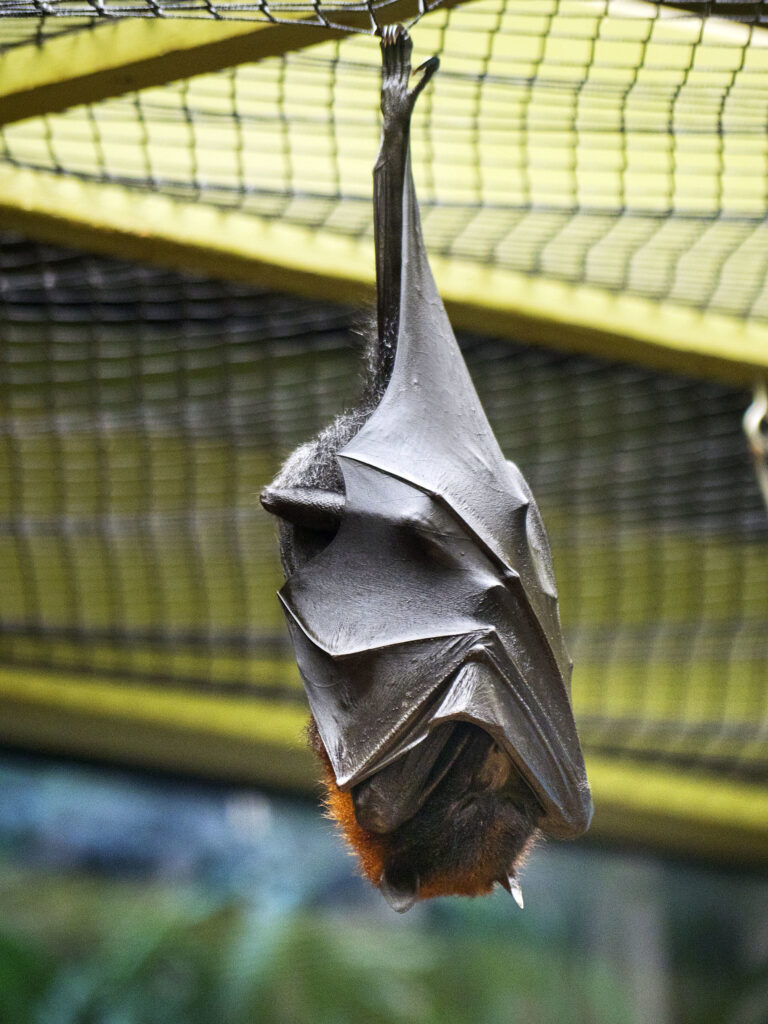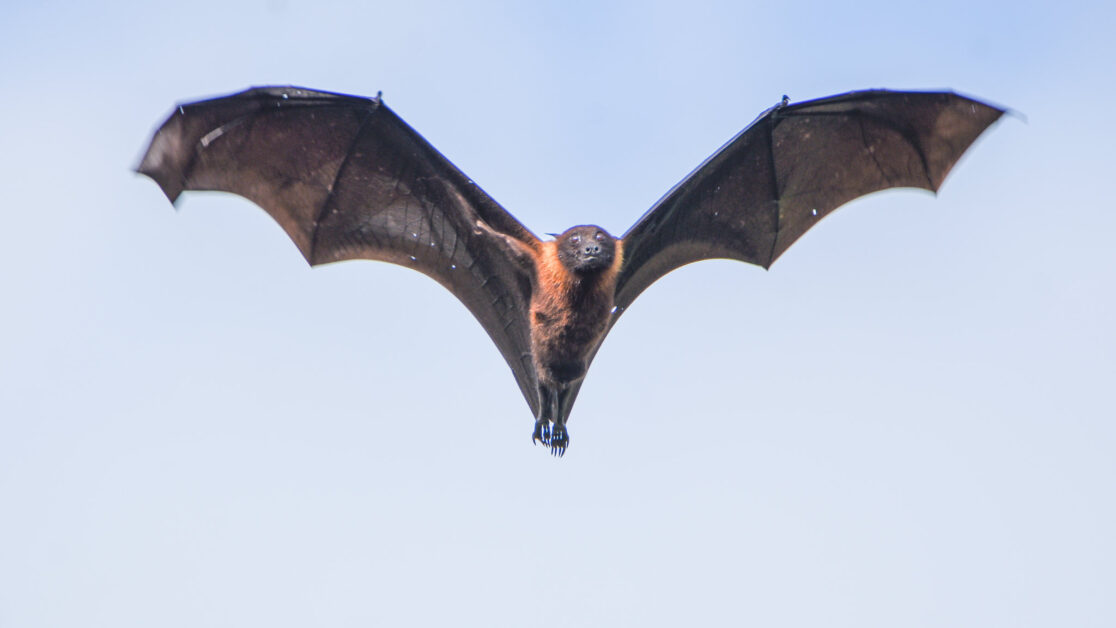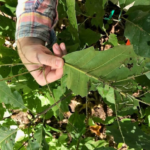Fight the Bat Killing Fungus
A terrifying bat killing fungus is tearing through North American bat populations—and scientists have finally found a way to fight back.
By Vered Smith
White-nose syndrome, a disease with a deceptively cute appearance, is killing millions of bats in North America. Encouraging research demonstrates that cooling down bat homes is a way to combat it.
White-nose syndrome, caused by the fungus Pseudogymnoascus destructans (Pd), is an illness that only affects hibernating bats. The fungus grows on their skin, coating their noses, ears, and wings with white fuzz—hence the name. Although it is a new disease first seen in 2006, its effects have been felt rapidly, killing 90 to 100 percent of bats in some bat sites. It causes death in 12 known species of bats, including the endangered gray bats and Indiana bats. Since there is currently no cure, it is imperative that scientists develop ways to help bats fight this death-dealing disease.
Scientists at Ohio University have found that cooling down the places bats hibernate (hibernacula) raises the number of bats after the winter compared to unchanged hibernacula. This is exciting news because it proves a practical way for scientists and conservationists to prevent bat death and to increase their populations.
Battling the bat killing fungus
When the bat killing fungus comes into contact with a host animal, it starts growing on the outside of the bat’s skin. Under the right conditions, it continues to grow and breaks through the skin, spreading into the bat’s body. As the fungus thrives within the bat, it injures and inflames its host’s tissues. What makes things worse is that a lot of growth happens on the bat’s wings and tails—limbs with important roles: regulating body temperature, maintaining correct water levels, carrying out gas exchange, and working the immune system. When these limbs are attacked, it sets off a chain of events causing the bat to increase its body temperature and wake up from hibernation (using energy it is meant to be saving to get through the winter without food). Two major problems follow: water loss and fat loss, ultimately resulting in dehydration, starvation, and death.
Past experiments have shown that colder temperatures and higher humidity result in lower growth of bat-killing fugus and higher bat survival. Researchers think this occurs because it slows down fungus growth, so it is less likely to kill the bats. Cold temperatures also minimize bats’ fat loss by lowering the amount of energy they use (their metabolic rate), and a higher humidity limits dehydration.
The scientists in this study aimed to manipulate natural cave temperatures to create an environment where bats are more likely to survive the winter and not fall prey to bat killing fungus. Cooling down hibernacula required different methods for different sites. In limestone caves they created extra entrances so cold air was let in and warm air was let oùt, and in sandstone mines they blocked the passageways that allowed cold air to leave. They also placed humidity data loggers to measure the humidity of each hibernacula, so they could compare sites and calculate the effects of humidity on white-nose syndrome.
The researchers found that four species of bats (Myotis lucifugus, Eptesicus fuscus, Myotis leibii, and Myotis septentrionalis) had higher numbers after hibernation in hibernacula with colder temperatures (2.1 °C cooler on average), especially in areas where the normal mid-winter temperature is 3–6 °C. Furthermore, three of those species had more bats after hibernating in hibernacula with higher humidity levels.


The truth about bats
Although bats have a bad reputation at the moment, especially regarding bat-human virus transmission, they play an essential role in our world. Bats are really large insect eaters. When bat populations decline, farmers use more pesticides that harm the environment. Bats are also large pollinators of fruits and plants: for example, the agave plant is reliant on bats to pollinate it so it can reproduce. Tequila is made from agave plants, so if you’re a fan, you can thank bats for your next tequila drink!
Read more: Bats Protect Plants from Insects
Bats are also eaten by animals such as hawks, owls, and weasels, and give food to smaller animals through their droppings. So when the bat population is out of balance, it derails the whole ecosystem, with far-reaching impacts on other animals.
There are so many super cool facts about bats—the list goes on! For instance, bats are the only mammals that can properly fly. The fastest bat (the Mexican free-tailed bat) can fly up to 100 mph in short bursts. An anti-blood-clotting molecule (anticoagulant) has been found in vampire bats’ saliva that is now being used in medicines to prevent strokes.
So what can you do to help bats?
Well, you can visit websites such as Bat Conservation International (batcon.org) to learn more about bats and ways to get involved, such as donating, becoming a member, buying merchandise, and adopting a bat, among other things. You can attend educational programs, or volunteer to teach others about the amazing things bats do, or join in events celebrating bats such as Bat Week in October. And if you live in or near bat habitats, always decontaminate caving gear before and after you’re in the caves and don’t disturb bats hibernating there. You can also report unusual bat behavior, such as bats flying during the day between December and March (when they should be hibernating), to a local bat conservation group.
Our support for scientists and conservationists can bring their research into a real plan of action so this bat killing fungus disappears and bats are able to wake up healthy from hibernation in the spring.
Watch a video about bats
The island of Cuba is a key piece of the puzzle for two researchers who are studying bats and trying to understand biodiversity in the Caribbean. Find out why on an expedition with mammalogists J. Angelo Soto-Centeno and Gilberto Silva Taboada, joined by Ana Luz Porzecanski, director of the Museum’s Center for Biodiversity and Conservation.
Watch the Shelf Life Video: Into the Island of Bats
This study was published in the journal Conservation Biology.
References
Hoyt, J. R., Kilpatrick, A. M., & Langwig, K. E. (2021). Ecology and impacts of white-nose syndrome on bats. Nature Reviews Microbiology, 19(3), 196–210. https://doi.org/10.1038/s41579-020-00493-5
Turner, G. G., Sewall, B. J., Scafini, M. R., Lilley, T. M., Bitz, D., & Johnson, J. S. (2021). Cooling of bat hibernacula to mitigate white-nose syndrome. Conservation Biology. doi:10.1111/cobi.13803
About the Author
Vered Smith comes from London, England, and is currently studying Medical Genetics in university there. Although she tries to avoid being a cliché, it can’t be denied that her favorite way to write is having a mug of tea (with milk, of course) in hand.
Featured photo by Deven Dadbhawala, CC 2.0




